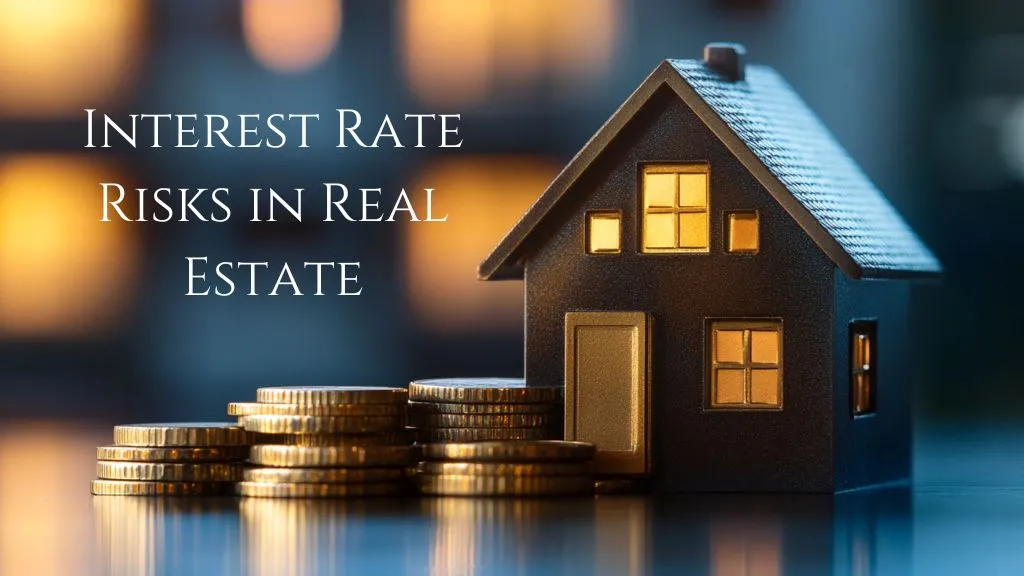
Property values, investments, and financing costs are highly influenced by the economy, in which interest rates are significant. Real estate for a homeowner, investor, or developer comes with interest rate risk that could lead to uninformed decisions if not taken care of.
Mortgage payments, investment returns, and property values can all be adversely affected due to randomly rising interest rates. On the other hand, falling rates can boost affordability and demand, driving prices higher.
The following parts of this article will discuss how house prices and interest rate risks correlate. They will also examine other types of interest rate risks and strategies for helping real estate investors mitigate rate change risks.
What Is Interest Rate Risk?
Interest rate risk is the potential impact of changing interest rates on financial assets, including real estate investment. Interest rates control the cost of borrowing, property value, and return on investment, so they are an essential aspect of real estate.
For real property investors, interest rate risk can affect cash flow, terms of financing, and limitations on the profitability of an investment in general. Understanding what influences interest rate changes can help real estate costs manage interest rate-related risk.
Types of Interest Rate Risk in Real Estate
Real estate interest rate risk can be divided into different types that affect various factors in the market. The significant types of interest rate risk include:
1. Price Risk
Price risk is the general principle that there is an inverse relationship between interest rates and real estate values. Typically, as interest rates increase, borrowing costs also increase, affordability decreases, and demand declines, and over time this can typically lead to declining values.
2. Reinvestment Risk
Reinvestment risk occurs when declining interest rates reduce the returns on real estate investments. To continue with our example, one risk is if the investor holds property with a fixed-interest mortgage, and once he has made his plans, interest rates decline, preventing the investor from refinancing at a lower interest rate.
3. Credit Risk
Higher interest rates are a reflection of tighter credit conditions, and often make it difficult for individuals and businesses to secure loans. These trends have a direct impact on the demand for real estate – particularly commercial and investment real estate because, in most cases, financing stands as the primary driver of demand.
4. Liquidity Risk
As interest rates climb, real estate transactions tend to come to a standstill, decreasing liquidity in the market. Sellers will also find it challenging to locate a buyer willing and able to pay the higher borrowing costs.
5. Inflation Risk
Inflation goes hand in hand with interest rates. In general, when inflation rises, central banks will raise rates to curb inflation. The effect is not only an increased cost to finance, but operating costs increase, effectively lowering profitability.
Interest Rates and Real Estate: How They Are Connected?
The real estate market is very responsive to interest rate changes. Being aware of the relationship between interest rates and real estate will enable an investor or homeowner to make more informed economic decisions.
1. Mortgage Rates and Affordability
One of the most straightforward impacts of interest rates on real estate is through mortgage rates. When interest rates increase, mortgage rates increase, increasing the cost to own a home. This pulls the number of qualified buyers out of the market, lowering demand and slowing price appreciation. When interest rates decrease, borrowing to purchase a home becomes less expensive, increasing demand for properties and driving prices higher.
2. Investment Property Valuation
For commercial real estate investors, financing is required to purchase property. Therefore, rising interest rates lead to rising borrowing costs, creating lower net income and a reduction in property values. Furthermore, the discount rate increases, which decreases the present value of future cash flows in the property, creating less desire for real estate investing.
3. Capital Flows and Real Estate Development
Interest rates determine the capital supply in the property market. Developers can borrow at low costs and low interest rates, spurring building activity. However, borrowing at high rates is costly, dampening new construction and curbing supply.
Interest Rates and House Prices: The Impact on the Housing Market
The Impact on Housing Market The association of interest rates to house prices in the housing market is complex but follows general economic principles. Here’s how interest rates vary with residential real estate:
1. Rising Interest Rates and House Prices
What happens when interest rates rise?
- Mortgage loans become more expensive and increase affordability.
- Demand for housing falls, including less price appreciation, and possibly falls in price.
- Homeowners may delay selling if locked in low-interest mortgages, reducing housing inventory.
2. Falling Interest Rates and House Prices
When interest rates decrease:
- Lowering borrowing rates makes homeownership affordable.
- Housing demand rises, and property prices go up.
- More consumers enter the market, increasing competition and sales.
3. Interest Rate Volatility and Market Uncertainty
Uncertainty about interest rate fluctuations can lead to fluctuations in housing prices. Unpredictable rate increases can result in steep drops in home prices, while extended low rates can lead to housing bubbles.
What are the Strategies to Mitigate Interest Rate Risk in Real Estate?
With the effect that changes in interest rates have on real estate, homeowners and investors must implement measures to counter the risk. The following are some successful methods of interest rate risk management:
- Lock in Fixed-Rate Mortgages
Opting for fixed-rate mortgages protects borrowers from rising interest rates. Unlike adjustable-rate mortgages (ARMs), fixed-rate loans provide stability in monthly payments, reducing the risk of higher financing costs in the future.
- Diversify Investment Portfolios
Investors can reduce their exposure to interest rate movements by diversifying investments into various property types, regions, and options. This reduces the effect of a rate increase on an individual asset class.
- Monitor Economic Indicators
Monitoring economic trends, Federal Reserve policy, and inflation rates allows investors to foresee the direction of interest rates and adjust their investment strategies accordingly.
- Utilize Interest Rate Hedges
Sophisticated investors can employ interest rate swaps, futures, and caps to hedge interest rate risk. These financial products enable them to offset prospective losses due to increasing rates.
- Optimize Loan Structures
Negotiating better loan terms, including longer amortization or interest-only loans, can assist in cash flow management during times of increasing interest rates.
Conclusion
Anyone in the real estate business needs to comprehend interest rate risk. Interest rates influence mortgage affordability, property values, and returns on investment. Homeowners and investors can make sound financial decisions by identifying the forms of interest rate risk, examining the relationship between interest rates and real estate, and knowing how interest rates influence house prices.
Risk management techniques, such as choosing fixed-rate mortgages, diversifying investments, and tracking economic indicators, can help offset the impact of interest rate fluctuations. As the real estate business grows, awareness of interest rate patterns will remain crucial to its ultimate success.
Interest Rate Risks in Real Estate FAQs:
1. What is the risk of interest rates?
2. What is the most significant risk of real estate investment?
1. Market Risk—The potential decline in property values due to economic changes.
2. Financial Risk—The risk of increased borrowing costs or inability to secure financing.
3. Liquidity Risk—Difficulty in quickly selling a property without losing value.
4. Operational Risk—Property management, maintenance, or tenant turnover issues.
5. Regulatory Risk—Changes in laws, taxes, or zoning regulations affecting property value.
6. Physical Risk—Damage from natural disasters, structural issues, or environmental hazards.
3. What is the least risky real estate investment?
1. Rental Properties in Stable Markets—These provide consistent income with lower market fluctuations.
2. Real Estate Investment Trusts (REITs)—Offers diversification and liquidity with lower capital requirements.
3. House Hacking—Living in one unit while renting out others to offset costs.
4. Turnkey Properties—Ready-to-rent properties with minimal management effort.
5. Crowdfunding—Investing small amounts in real estate projects with shared risk.
6. Triple Net Lease Properties—Long-term leases where tenants cover most expenses, reducing risk.






